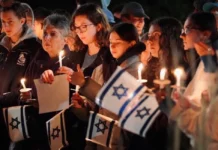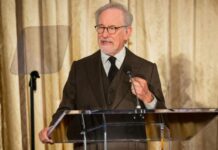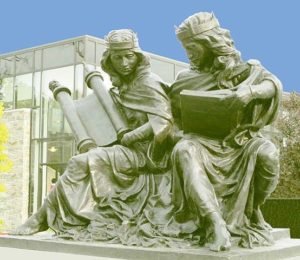
Near the entrance of Saint Joseph’s University’s Chapel of Saint Joseph–Michael J. Smith, S.J. Memorial, sits a sculpture, “Synagoga and Ecclesia in Our Time” by Jewish Philadelphia-based artist Joshua Koffman. Forged in bronze are two figures holding the respective holy books of Judaism and Christianity and studying together.
Erected in 2015, the statue represented a renewed urgency to foster ties between the Catholic and Jewish religions. That same year, Pope Francis attended a dedication of the statue and visited St. Joseph’s. Following the visit, the Jesuit-affiliated campus experienced a collective interest in developing interreligious ties.
Seven years later, the reverberations of this initial push aren’t obvious. In a student population of 6,779, there are about 60 identified Jewish students. The school has no cohesive Jewish community, but the tides are once again changing.
Following three COVID-affected academic years, students at St. Joe’s are experiencing a renaissance of student engagement. The college’s acquisition of the Philadelphia private school University of the Sciences means it must reckon with the addition of a new student body with varied religious identities.
After a symbolic commitment to strengthening interreligious ties, the college is looking to fulfill its promise of promoting religious diversity more tangibly.
On the Main Line, St. Joe’s is joined by Villanova University, another Catholic-affiliated college with a budding Jewish community. This year, the Greater Philly Hillel Network, a Hillel organization working with students at Bryn Mawr and Haverford Colleges and West Chester University, has hired a new rabbinical intern to spend more time on campus and a Springboard Innovation Fellow to more deeply engage with the school’s Jewish students.
As the new academic year nearly coincides with the Jewish New Year, there’s a growing sense that this will be the year when the Jewish student population on these two Christian campuses becomes an institutionalized and unified group.
“We’ve set modest goals for the coming year and are really exploring what the future might bring,” Greater Philly Hillel Network Executive Director Rabbi Jeremy Winaker said. “Our modest goals include developing the leadership pipeline for the Hillel at Villanova and establishing a Hillel at St. Joe’s.”
Villanova created a Hillel several years ago with the help of Campus Ministry. Greater Philly Hillel began the partnership in August 2021 and, since then, the organization has experienced “waxing and waning” student support and attendance, according to Reconstructionist Rabbinical College rabbinical intern Aviva Marchione.
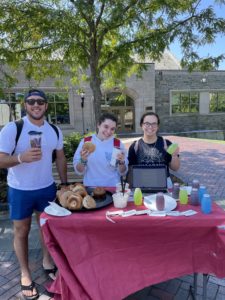
Marchione works with students at Villanova’s campus for eight hours a week, sitting down for coffee and a meal with students or hosting dinners, such as on Rosh Hashanah and break the fast. Usually, a handful of students attend each event.
In previous years, a rabbinical intern was only on campus for two hours per week. In addition to Marchione’s increased presence, Springboard fellow Sean Culley is on campus, tasked with engaging students and gathering information on what makes them tick.
As students emerge from a COVID-induced student engagement hibernation, identifying student interests is increasingly important.
“Talking with students, there’s a clear need for community and just relationships with other Jews — a space just for Jewish students to be Jewish together is the biggest need,” Marchione said. “I have realized that that is a higher need than any sort of Jewish identity-building or Jewish learning.”
As Culley has spoken with students at Villanova, he’s noticed a shift in the way they engage with student life. There used to be a “bread and butter” formula students would follow: They’d see a poster around campus or a post on Instagram about an event, and then they’d show up. Now, however, students are looking to be engaged more personally.
“Students, everybody involved in Jewish community at Villanova and St. Joe’s, is just looking for people to relate to, for people to understand them and for people that want to help them grow in their own personal lives, whether it be their Jewish journey or not,” Culley said.
Changing student needs means that Marchione and Culley are still trying to figure out how to get students to show up.
“The Jewish community at Villanova is really still kind of amorphous,” Marchione said. “It’s still such in its early phases that it’s hard to draw any conclusions at this point.”
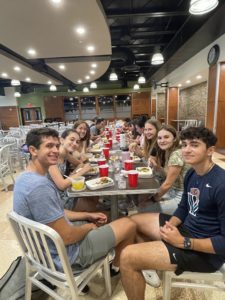
St. Joe’s’ Jewish community has been even more ambiguous in recent years, with the school’s few Jewish professors doing their best to engage with the campus’ Jewish students.
Nancy Fox, a professor of economics at St. Joe’s, has helped lead the charge in building Jewish community on campus. She’s worked at the college for 37 years but only began engaging with Jewish students after 10 years of teaching.
Fox had an epiphany when speaking to a colleague, Sister Francis. During her previous teaching career at New York University, she made hamantaschen for Purim every year for her sizable Jewish population. She debated making the cookies for her students at St. Joe’s and finally decided to after Sister Francis told her that Catholics also study the story of Esther.
“And that’s when it clicked,” she said.
With the help of congregants at Congregation Beth El-Ner Tamid in Broomall, Fox and members of Campus Ministry dropped off shalach manot to Jewish students on campus.
Fifteen years ago, Fox helped organize an interfaith service to kick off the spring semester, complementing the Catholic mass that took place at the beginning of each fall semester. She’s helped organize a Passover seder at the college for the past ten years.
Through her time working with Jewish students and organizing interfaith activities with Campus Ministry, she’s noticed a parallel between their stories and hers: “It kind of awakened their Jewish identity. Most of these students, to my knowledge — the ones who I know — do not actively practice Judaism. And I have a feeling that this reminds them that they’re Jewish.”
With little infrastructure in place to support Jewish community before Greater Philly Hillel’s involvement, why would Jewish students choose to attend a school where they knew they would be the religious minority? When they knew, in the case of Villanova, that they would enter buildings donned with crosses and learn in classrooms adorned with a crucifix?
Evan Koss, who is in his last semester at St. Joe’s, matriculated to the school because he was drawn to their food marketing program, which he deemed highly competitive. He grew up in the area and attended the Conservative Kesher Israel Congregation in West Chester. As he was getting ready to graduate high school, he knew he wanted to stay in the area for college.
“St. Joe’s is right next to Lower Merion, which is a very heavily Jewish area,” Koss said. “I have family that lives in Ardmore, kind of minutes away, so I was familiar with the area to begin with.”
According to Culley, other Jewish students at St. Joe’s share Koss’ experience. They are commuter students from the heavily Jewish Main Line wanting to major within one of the competitive but specific programs St. Joe’s has to offer.
At Villanova, Jewish students are drawn to the college’s basketball team and its lively campus life, Culley said. The college offers good financial aid.
These Jewish students are aware of what they’re getting into.
“I fully accepted the risk of going to a religious school that wasn’t my own and all that would entail with it,” Koss said.
During his four years at St. Joe’s, Koss doesn’t recall instances of antisemitism, but he has become an “unintentional mouthpiece,” having to educate some of his classmates about his religion.
“There’s just a lack of education because a lot of students … they’ve been in Catholic school since they were kindergarten through 12th grade, and then they went right to a Catholic [college]; they may not have been exposed to Jewish people or Jewish culture,” Koss said.
While Koss didn’t mind doing some work to educate his classmates, he was also looking to connect with students who shared his Jewish upbringing. Before the semester began, he talked with six Jewish students, most of whom had not previously been interested in becoming involved in Jewish life on campus.
Koss worked with Winaker and Culley to create a Jewish presence at activity fairs, where students interested in Hillel could put their emails on a listserv. Beth Ford McNamee, assistant director in the Office of Campus Ministry, has worked with Greater Philly Hillel and the Jewish students to try to eliminate barriers to holding programming, such as reserving spaces or navigating the student organization formation process.
According to McNamee, St. Joe’s has always tried to be respectful of religious diversity; it’s part of the core tenets of Catholic values. Villanova has shared similar values, following the changing philosophy of the Catholic Church, according to Villanova’s Director of Multifaith Ministry Rev. Julie Sheetz.
In 1965, the Second Vatican Council met and created the declaration Nostra Aetate, “when the church really began to wrestle with its relationship to modernity,” Sheetz said. Among other ideas, the declaration grappled with its role in antisemitism and the fate of Jews during the Holocaust, advocating for increased correspondence with other religious groups.
In 1967, St. Joe founded its Institute for Jewish-Catholic Relations, promoting coursework on non-Christian religions and speaker series promoting interreligious connections. “Synagoga and Ecclesia in Our Time” marked the 50th anniversary of Nostra Aetate and acted as a reminder of the work St. Joe’s still had to do to create a truly religiously diverse campus climate.
Villanova has a similar reaction to Nostra Aetate’s 50th anniversary. According to Sheetz, the theology department hired a professor of interreligious studies and a Jewish professor for Hebrew Bible and Jewish studies courses.
As both Villanova and St. Joe’s faculty and staff have coalesced to support Jewish students, and with increasing Jewish infrastructure created by Greater Philly Hillel, the onus to build a sustained Jewish community is now on the students.
While Marchione and Culley have seen evidence of momentum and excitement from students, students need to continue to lend their insights and time to ensure these projects can come to fruition.
“It’s sort of chicken-and-egg,” Sheetz said. “It’s hard to attract more Jewish students if there’s not already vibrant evidence of a lot of Jewish students on campus.”



